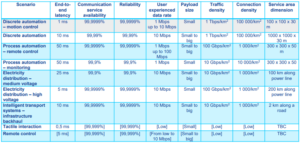Introduction
5G is rapidly coming close bringing with it the promise of powerful new use cases that will require a flexible technology that can provide ultra-reliable low latency (uRLLC), massive machine-type communications (mMTC), and much huge faster data rates with enhanced Mobile Broadband (eMBB).
So, the expectation in the industry is growing for the Internet of Things (IoT), so requirements for URLLC have been set anticipating integration in industries other than mobile communications, such as automobiles, robots, and sensors.
URLLC Use Cases
URLLC is targeted mainly for services like traffic control or remote control, which require both high reliability and low latency.
Example:
- Control of Autonomous Vehicles and Traffic control, this involves sending warning signals between different vehicles, roadways and even pedestrians to control the traffic efficiency and support movement of emergency vehicles.
- Robot Control and 3D Connection with Drones and other devices, as the manufacturing automation using robots, is anticipated and control of this is a use case for 5G. It’s also expected to control drones and other devices in the air remotely.
- Remote Surgery, It can be implemented using optical communications but it’s difficult to apply in disaster areas or other dangerous situations. So, it’s one of the use cases for 5G.

URLLC Use Cases (Source: Nokia)
All the above use cases need high reliability and low latency and mobility rather than high transmission speed or a large number of connected terminals. So, the question now what are the URLLC requirements?
URLLC Requirements
Ensuring low-latency and ultra-reliable communication for future wireless networks is of capital importance as the main requirements for URLLC.
- Latency
There’s are different definitions of Latency as below:- End-to-End Latency and this include the over the air transmission delay, queuing delay, processing/computing delay and retransmission.
- User Plan Latency (3GPP), defined as the one-way time it takes to successfully deliver an application layer packet/message from the radio protocol layer ingress point to the radio protocol ingress point of the radio interface, in either uplink or downlink in the network for a given service in unloaded conditions (assuming the user equipment (UE) is in active state).
- Control Plan Latency (3GPP), defined as the transition time from a most “battery efficient” state (e.g., idle state) to the start of continuous data transfer (e.g. active state).
The URLLC requirements from 3GPP RAN TR 38.913 for the latency is as below:
-
-
- Control Plane Latency: 10 msec.
- User Plan Latency: 0.5 msec for both UL and DL.
-
- Reliability
In general, reliability is defined as the probability that a data of size D is successfully transferred within a time period T. However, other definitions can be encountered:
-
- Reliability (3GPP): capability of transmitting a given amount of traffic within a predetermined time duration with high success probability.
The URLLC requirements from 3GPP RAN TR 38.913 for the Reliability is 1-10^-5 for 32 bytes with a user plane latency of 1ms.
- Reliability (3GPP): capability of transmitting a given amount of traffic within a predetermined time duration with high success probability.
URLLC Use Cases and Requirements
As per 3GPP TS 22.261, Table 7.2.21 performance requirements for low latency and high-reliability scenarios.

Performance requirements for low-latency and high-reliability scenarios (Source: 3GPP)
Issues in meeting URLLC Requirements
To meet URLLC requirements for reducing latency requires:
- Reducing radio signal transmission time, the longer the slot length the longer the transmission time, so reducing the slot length is desirable.
- Reducing the time needed for transmission, it’s mandatory to reduce the time for the retransmission of the lost packets to achieve both high reliability and low latency.
Conclusion:
This article has given an overview of URLLC as a 5G use case and the different requirements for best performance from low latency to high reliability.
Also, to support future services with flexibility, it’s desirable to increase the volumes of data that can be transmitted while satisfying the URLCC requirements.
References:
- 3GPP TS 22.261
- Nokia
- NTT DOCOMO.













